Yuexian Zou
SSVMR: Saliency-based Self-training for Video-Music Retrieval
Feb 18, 2023Abstract:With the rise of short videos, the demand for selecting appropriate background music (BGM) for a video has increased significantly, video-music retrieval (VMR) task gradually draws much attention by research community. As other cross-modal learning tasks, existing VMR approaches usually attempt to measure the similarity between the video and music in the feature space. However, they (1) neglect the inevitable label noise; (2) neglect to enhance the ability to capture critical video clips. In this paper, we propose a novel saliency-based self-training framework, which is termed SSVMR. Specifically, we first explore to fully make use of the information containing in the training dataset by applying a semi-supervised method to suppress the adverse impact of label noise problem, where a self-training approach is adopted. In addition, we propose to capture the saliency of the video by mixing two videos at span level and preserving the locality of the two original videos. Inspired by back translation in NLP, we also conduct back retrieval to obtain more training data. Experimental results on MVD dataset show that our SSVMR achieves the state-of-the-art performance by a large margin, obtaining a relative improvement of 34.8% over the previous best model in terms of R@1.
Generating Templated Caption for Video Grounding
Jan 15, 2023Abstract:Video grounding aims to locate a moment of interest matching the given query sentence from an untrimmed video. Previous works ignore the \emph{sparsity dilemma} in video annotations, which fails to provide the context information between potential events and query sentences in the dataset. In this paper, we contend that providing easily available captions which describe general actions \ie, templated captions defined in our paper, will significantly boost the performance. To this end, we propose a Templated Caption Network (TCNet) for video grounding. Specifically, we first introduce dense video captioning to generate dense captions, and then obtain templated captions by Non-Templated Caption Suppression (NTCS). To utilize templated captions better, we propose Caption Guided Attention (CGA) project the semantic relations between templated captions and query sentences into temporal space and fuse them into visual representations. Considering the gap between templated captions and ground truth, we propose Asymmetric Dual Matching Supervised Contrastive Learning (ADMSCL) for constructing more negative pairs to maximize cross-modal mutual information. Without bells and whistles, extensive experiments on three public datasets (\ie, ActivityNet Captions, TACoS and ActivityNet-CG) demonstrate that our method significantly outperforms state-of-the-art methods.
Towards Unified All-Neural Beamforming for Time and Frequency Domain Speech Separation
Dec 24, 2022Abstract:Recently, frequency domain all-neural beamforming methods have achieved remarkable progress for multichannel speech separation. In parallel, the integration of time domain network structure and beamforming also gains significant attention. This study proposes a novel all-neural beamforming method in time domain and makes an attempt to unify the all-neural beamforming pipelines for time domain and frequency domain multichannel speech separation. The proposed model consists of two modules: separation and beamforming. Both modules perform temporal-spectral-spatial modeling and are trained from end-to-end using a joint loss function. The novelty of this study lies in two folds. Firstly, a time domain directional feature conditioned on the direction of the target speaker is proposed, which can be jointly optimized within the time domain architecture to enhance target signal estimation. Secondly, an all-neural beamforming network in time domain is designed to refine the pre-separated results. This module features with parametric time-variant beamforming coefficient estimation, without explicitly following the derivation of optimal filters that may lead to an upper bound. The proposed method is evaluated on simulated reverberant overlapped speech data derived from the AISHELL-1 corpus. Experimental results demonstrate significant performance improvements over frequency domain state-of-the-arts, ideal magnitude masks and existing time domain neural beamforming methods.
M3ST: Mix at Three Levels for Speech Translation
Dec 07, 2022Abstract:How to solve the data scarcity problem for end-to-end speech-to-text translation (ST)? It's well known that data augmentation is an efficient method to improve performance for many tasks by enlarging the dataset. In this paper, we propose Mix at three levels for Speech Translation (M^3ST) method to increase the diversity of the augmented training corpus. Specifically, we conduct two phases of fine-tuning based on a pre-trained model using external machine translation (MT) data. In the first stage of fine-tuning, we mix the training corpus at three levels, including word level, sentence level and frame level, and fine-tune the entire model with mixed data. At the second stage of fine-tuning, we take both original speech sequences and original text sequences in parallel into the model to fine-tune the network, and use Jensen-Shannon divergence to regularize their outputs. Experiments on MuST-C speech translation benchmark and analysis show that M^3ST outperforms current strong baselines and achieves state-of-the-art results on eight directions with an average BLEU of 29.9.
Aligning Source Visual and Target Language Domains for Unpaired Video Captioning
Nov 22, 2022Abstract:Training supervised video captioning model requires coupled video-caption pairs. However, for many targeted languages, sufficient paired data are not available. To this end, we introduce the unpaired video captioning task aiming to train models without coupled video-caption pairs in target language. To solve the task, a natural choice is to employ a two-step pipeline system: first utilizing video-to-pivot captioning model to generate captions in pivot language and then utilizing pivot-to-target translation model to translate the pivot captions to the target language. However, in such a pipeline system, 1) visual information cannot reach the translation model, generating visual irrelevant target captions; 2) the errors in the generated pivot captions will be propagated to the translation model, resulting in disfluent target captions. To address these problems, we propose the Unpaired Video Captioning with Visual Injection system (UVC-VI). UVC-VI first introduces the Visual Injection Module (VIM), which aligns source visual and target language domains to inject the source visual information into the target language domain. Meanwhile, VIM directly connects the encoder of the video-to-pivot model and the decoder of the pivot-to-target model, allowing end-to-end inference by completely skipping the generation of pivot captions. To enhance the cross-modality injection of the VIM, UVC-VI further introduces a pluggable video encoder, i.e., Multimodal Collaborative Encoder (MCE). The experiments show that UVC-VI outperforms pipeline systems and exceeds several supervised systems. Furthermore, equipping existing supervised systems with our MCE can achieve 4% and 7% relative margins on the CIDEr scores to current state-of-the-art models on the benchmark MSVD and MSR-VTT datasets, respectively.
A Dynamic Graph Interactive Framework with Label-Semantic Injection for Spoken Language Understanding
Nov 08, 2022Abstract:Multi-intent detection and slot filling joint models are gaining increasing traction since they are closer to complicated real-world scenarios. However, existing approaches (1) focus on identifying implicit correlations between utterances and one-hot encoded labels in both tasks while ignoring explicit label characteristics; (2) directly incorporate multi-intent information for each token, which could lead to incorrect slot prediction due to the introduction of irrelevant intent. In this paper, we propose a framework termed DGIF, which first leverages the semantic information of labels to give the model additional signals and enriched priors. Then, a multi-grain interactive graph is constructed to model correlations between intents and slots. Specifically, we propose a novel approach to construct the interactive graph based on the injection of label semantics, which can automatically update the graph to better alleviate error propagation. Experimental results show that our framework significantly outperforms existing approaches, obtaining a relative improvement of 13.7% over the previous best model on the MixATIS dataset in overall accuracy.
NoreSpeech: Knowledge Distillation based Conditional Diffusion Model for Noise-robust Expressive TTS
Nov 04, 2022Abstract:Expressive text-to-speech (TTS) can synthesize a new speaking style by imiating prosody and timbre from a reference audio, which faces the following challenges: (1) The highly dynamic prosody information in the reference audio is difficult to extract, especially, when the reference audio contains background noise. (2) The TTS systems should have good generalization for unseen speaking styles. In this paper, we present a \textbf{no}ise-\textbf{r}obust \textbf{e}xpressive TTS model (NoreSpeech), which can robustly transfer speaking style in a noisy reference utterance to synthesized speech. Specifically, our NoreSpeech includes several components: (1) a novel DiffStyle module, which leverages powerful probabilistic denoising diffusion models to learn noise-agnostic speaking style features from a teacher model by knowledge distillation; (2) a VQ-VAE block, which maps the style features into a controllable quantized latent space for improving the generalization of style transfer; and (3) a straight-forward but effective parameter-free text-style alignment module, which enables NoreSpeech to transfer style to a textual input from a length-mismatched reference utterance. Experiments demonstrate that NoreSpeech is more effective than previous expressive TTS models in noise environments. Audio samples and code are available at: \href{http://dongchaoyang.top/NoreSpeech\_demo/}{http://dongchaoyang.top/NoreSpeech\_demo/}
DiMBERT: Learning Vision-Language Grounded Representations with Disentangled Multimodal-Attention
Oct 28, 2022



Abstract:Vision-and-language (V-L) tasks require the system to understand both vision content and natural language, thus learning fine-grained joint representations of vision and language (a.k.a. V-L representations) is of paramount importance. Recently, various pre-trained V-L models are proposed to learn V-L representations and achieve improved results in many tasks. However, the mainstream models process both vision and language inputs with the same set of attention matrices. As a result, the generated V-L representations are entangled in one common latent space. To tackle this problem, we propose DiMBERT (short for Disentangled Multimodal-Attention BERT), which is a novel framework that applies separated attention spaces for vision and language, and the representations of multi-modalities can thus be disentangled explicitly. To enhance the correlation between vision and language in disentangled spaces, we introduce the visual concepts to DiMBERT which represent visual information in textual format. In this manner, visual concepts help to bridge the gap between the two modalities. We pre-train DiMBERT on a large amount of image-sentence pairs on two tasks: bidirectional language modeling and sequence-to-sequence language modeling. After pre-train, DiMBERT is further fine-tuned for the downstream tasks. Experiments show that DiMBERT sets new state-of-the-art performance on three tasks (over four datasets), including both generation tasks (image captioning and visual storytelling) and classification tasks (referring expressions). The proposed DiM (short for Disentangled Multimodal-Attention) module can be easily incorporated into existing pre-trained V-L models to boost their performance, up to a 5% increase on the representative task. Finally, we conduct a systematic analysis and demonstrate the effectiveness of our DiM and the introduced visual concepts.
Video Referring Expression Comprehension via Transformer with Content-aware Query
Oct 06, 2022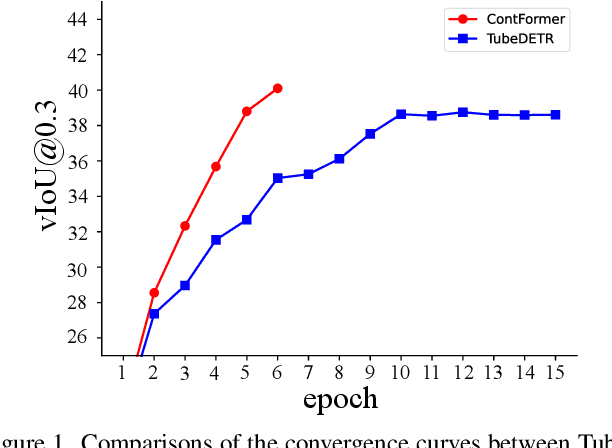
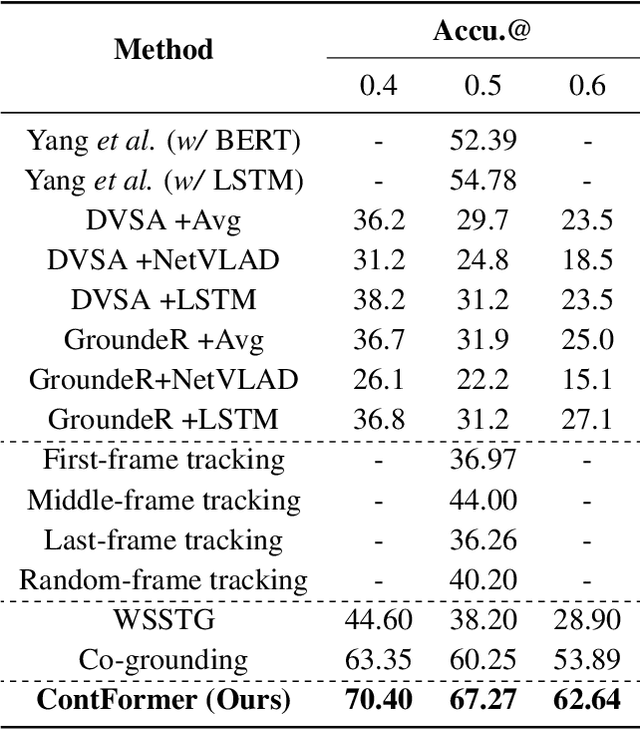
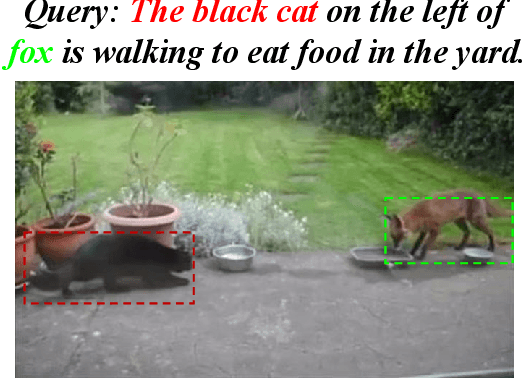

Abstract:Video Referring Expression Comprehension (REC) aims to localize a target object in video frames referred by the natural language expression. Recently, the Transformerbased methods have greatly boosted the performance limit. However, we argue that the current query design is suboptima and suffers from two drawbacks: 1) the slow training convergence process; 2) the lack of fine-grained alignment. To alleviate this, we aim to couple the pure learnable queries with the content information. Specifically, we set up a fixed number of learnable bounding boxes across the frame and the aligned region features are employed to provide fruitful clues. Besides, we explicitly link certain phrases in the sentence to the semantically relevant visual areas. To this end, we introduce two new datasets (i.e., VID-Entity and VidSTG-Entity) by augmenting the VIDSentence and VidSTG datasets with the explicitly referred words in the whole sentence, respectively. Benefiting from this, we conduct the fine-grained cross-modal alignment at the region-phrase level, which ensures more detailed feature representations. Incorporating these two designs, our proposed model (dubbed as ContFormer) achieves the state-of-the-art performance on widely benchmarked datasets. For example on VID-Entity dataset, compared to the previous SOTA, ContFormer achieves 8.75% absolute improvement on Accu.@0.6.
Correspondence Matters for Video Referring Expression Comprehension
Jul 21, 2022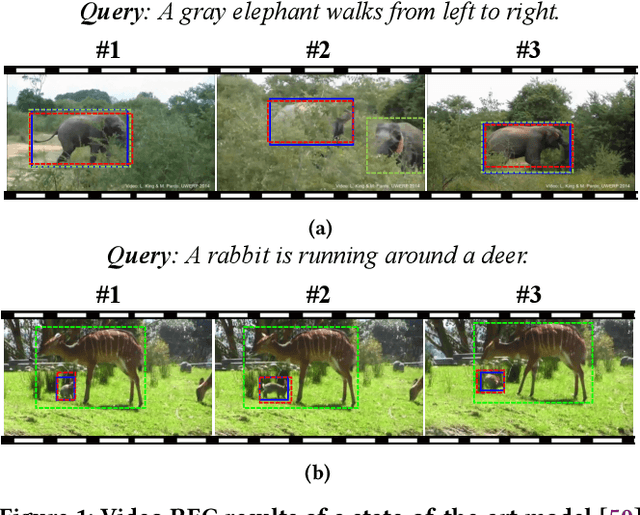
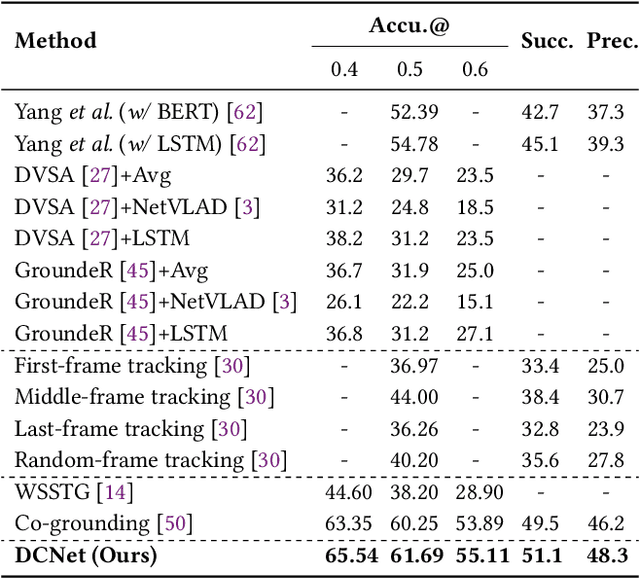

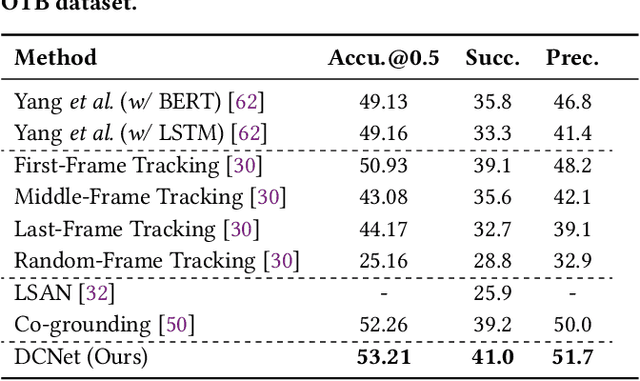
Abstract:We investigate the problem of video Referring Expression Comprehension (REC), which aims to localize the referent objects described in the sentence to visual regions in the video frames. Despite the recent progress, existing methods suffer from two problems: 1) inconsistent localization results across video frames; 2) confusion between the referent and contextual objects. To this end, we propose a novel Dual Correspondence Network (dubbed as DCNet) which explicitly enhances the dense associations in both the inter-frame and cross-modal manners. Firstly, we aim to build the inter-frame correlations for all existing instances within the frames. Specifically, we compute the inter-frame patch-wise cosine similarity to estimate the dense alignment and then perform the inter-frame contrastive learning to map them close in feature space. Secondly, we propose to build the fine-grained patch-word alignment to associate each patch with certain words. Due to the lack of this kind of detailed annotations, we also predict the patch-word correspondence through the cosine similarity. Extensive experiments demonstrate that our DCNet achieves state-of-the-art performance on both video and image REC benchmarks. Furthermore, we conduct comprehensive ablation studies and thorough analyses to explore the optimal model designs. Notably, our inter-frame and cross-modal contrastive losses are plug-and-play functions and are applicable to any video REC architectures. For example, by building on top of Co-grounding, we boost the performance by 1.48% absolute improvement on Accu.@0.5 for VID-Sentence dataset.
 Add to Chrome
Add to Chrome Add to Firefox
Add to Firefox Add to Edge
Add to Edge